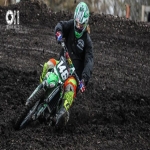Doctors at Kansas City Bone and Joint all focus on helping patients and athletes get back to their passions; even a passion as dangerous as motocross.
An administrator at our office has a son who has made a fairly successful career in motocross. This did not come without a few bumps and bruises. “Tucker started racing at 4 years old. He is now 21 and still going. He has raced motocross, endurocross, arenacross, and hare scrambles. All are scary for parents, all races are the same to me, there is zero adrenaline change for a parent watching their kid race motocross versus arenacross or a hare scramble, and in my case even watching him ride/practice is scary. Your heart races so fast and for me, I cannot breathe. Tucker races pro, those guys go pretty fast. Parents tend to pace a lot; there is no sitting down to watch your kid race.”- Fawn Smith

It’s all dangerous, but just like any other sport. He wears all the protection he can- high end/certified helmet, riding pants/jersey, gloves, neck protection. It doesn’t protect riders from everything. Injuries will still happen when you ride/race.

According to the American Academy of Orthopaedic Surgeons, a seven year long study of nearly 250 motocross athletes between the ages of 5-18 years old concluded that 95% of injuries sustained were musculoskeletal in nature!
Motocross is an injury heavy sport. So why do it?
“It’s my happy place, where I am most comfortable. It’s an absolute focus that can’t be found anywhere else. On the bike, everything else disappears. I focus on the quick changing conditions as brakes, clutch, throttle, and gears are manipulated carefully by me, all while having to simultaneously hold on. If my mind wanders even the slightest amount, a crash is in my near future.”
“It’s a ‘live in the present’ mindfulness, meaning there is no worry of what happened in the past or what could happen in the future, only what is happening at this exact second. When I make mistakes, I cannot dwell on it because that will lead to more mistakes. Any distraction could cost me, so I have to focus on the here and now above all else.”- Tucker Smith
If a motocross athlete goes down they typically go down big. Most motocross injuries require surgery given the type of terrain and high rates of speed. Though the sport is growing in popularity, parents should consider weighing the risks and benefits before allowing their children to participate in this sport.
Another common injury in motocross that often gets under treated is concussions
“Tucker crashed in 2013 racing a hare scramble and the video is on YouTube, I don’t like that it’s out there, but it is. That was his 2nd concussion but his more severe one. He was on brain rest for months. He has never stopped having headaches. He has had a few other smaller grade concussions since. He just finished concussion care treatment with a Neurophychologist and Physiatrists where he learned how to cope with the headaches and some anger issues. He takes medications for his headaches as they come about. The anger was new and came on gradually after his 4th concussion. He still continues to race and ride, but if he crashes he always gets checked out and watches for the signs and symptoms of another concussion. He does not race if he has a concussion.”- Fawn Smith
“Parents and coaches should be aware of concussion symptoms, and riders should avoid racing while experiencing these symptoms to prevent further injuries. After recovering from a concussion, riders should participate in supervised, progressive return-to-ride programs before returning to competitive racing.”-Dr. McIntosh (Department of Orthopedic Surgery, Texas Scottish Rite Hospital for Children, Dallas, Texas)
Despite all his injuries, he keeps going back for more. That’s really what Orthopaedics is about. To get people and athletes back to their passion in a safe manner; whether it be gardening or taking hair pin turns on a dirt track traveling at insane speeds.
The most common physical symptoms are:
- Headaches
- Nausea
- Dizziness
- Sleep disturbances (difficulty sleeping)
- Difficulty concentrating or remembering
- Moodiness. (people with concussions are typically more emotional than usual)
By Stephanie Jones & Fawn Smith

